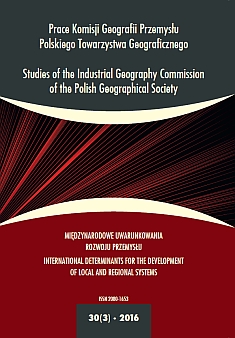Evolution of the Production and Employment Structures in Market Economies. Implications for Poland
DOI:
https://doi.org/10.24917/20801653.303.4Keywords:
deindustrialization, dualism of deindustrialization, reindustrialization, structural changeAbstract
Abstract: The paper presents the diversified problems of structural changes in market economies of highlydeveloped countries which have undergone heavy industrialization and in market economies of yet developingcountries and then experience premature deindustrialization. The cognitive layer of the article constitutesthe basis for the attempt at interpreting the effects of employment structure changes in the empiricallayer. The six-sector division of economy serves to explore the changes of employment in selected countriesfor the period of 1970-2014. The application of simple statistical tools discloses the relation between thestructure of employment in manufacturing and market services, and the level of GDP per capita. The mainemphasis however, is put on highlighting premature deindustrialization in Poland, and the need for reindustrializationin this type of market economies.Downloads
Metrics
References
Baumol, W.J., Blackman E.N., Wolff E.N. (1989). Productivity and American Leadership: the long view. Massachusetts, Cambridge: MIT Press.
Clark, C. (1957). The Conditions of Economic Progress. London: Macmillan.
Dasgupta, S., Singh, A. (2005). Will services be the new engine of economic growth in India? Centre for Business Research. University of Cambridge Working Paper, 310.
Dasgupta, S., Singh, A. (2006). Manufacturing, Services and Premature Deindustrialization in Developing Countries. A Kaldorian Analysis. UNU-WIDER WIDER Research Paper, 49.
Fisher, A.G.B. (1945). Economic Progress and Social Security. London.
Fisher, A.G.B. (1952). A note on tertiary production. The Economic Journal, 62.
Fourastié, J. (1954). Die Grosse Hoffnung des zwanzigsten Jahrhunderts. Köln-Deutz: Bund-Verlag.
Fourastié, J. (1972). Myśli przewodnie. Warszawa: PIW.
GUS (2016a, 3 lipca). Rachunki narodowe. Pozyskano z http://stat.gov.pl/statystyka-miedzynarodowa/ porownania-miedzynarodowe/tablice-o-krajach-wedlug-tematow/rachunki-narodowe/
GUS (2016b, 3 lipca). Roczne wskaźniki makroekonomiczne, wartość dodana brutto ogółem w cenach stałych z 2000 roku. Pozyskano z http://stat.gov.pl/wskazniki-makroekonomiczne/
GUS (2016c, 1 lipca). Tablice o krajach – przemysł i budownictwo. Pozyskano z http://stat.gov.pl/statystyka-miedzynarodowa/porownania-miedzynarodowe/tablice-o-krajach-wedlugtematow/ przemysl-i-budownictwo/
Kaldor, N. (1967). Strategic Factors in Economic Development. New York State School of Industrial and Labour Relations. Ithaca NY: Cornell University.
Karpiński, A., Paradysz, S., Soroka, P., Żółtkowski, W. (2015). Od uprzemysłowienia w PRL do deindustrializacji kraju. Warszawa: Wydawnictwo Muza SA.
Kłosiński, K.A. (2011). Światowy rynek usług w początkach XXI wieku. Warszawa: Polskie Wydawnictwo Ekonomiczne.
Kwiatkowski, E. (1980). Teoria trzech sektorów. Warszawa: PWN.
OECD (2016a). Stat Labour Force Statistics. DOI :10.1787/lfs-lfs-data-en OECD (2016b, 3 lipca). Pozyskano z http://stats.oecd.org/viewhtml.aspx?datasetcode=SNA_ TABLE3&lang=en#
Piketty, T. (2015). Kapitał XXI wieku. Warszawa: Wydawnictwo Krytyki Politycznej.
Rifkin, J. (2001). Koniec pracy. Schyłek siły roboczej na świecie i początek ery postrynkowej. Wrocław: Wydawnictwo Dolnośląskie.
Rifkin, J. (2011). Trzecia rewolucja przemysłowa. Katowice: Wydawnictwo Sonia Draga.
Rodrik, D. (2016). Premature deindustrialization. Journal of Economic Growth, 21.
Rowthorn, R., Ramaswamy, R. (1997). Deindustrialization: causes and implications. IMF Working Paper, 42.
Waląg P. (2012). Determinanty zmian struktury zatrudnienia w okresie transformacji gospodarki polskiej. Uniwersytet Opolski, Wydział Ekonomiczny (niepublikowana praca doktorska).
Downloads
Published
How to Cite
Issue
Section
License
Articles are published under the terms of the Creative Commons License (CC BY-ND 4.0; Attribution– NoDerivs).

